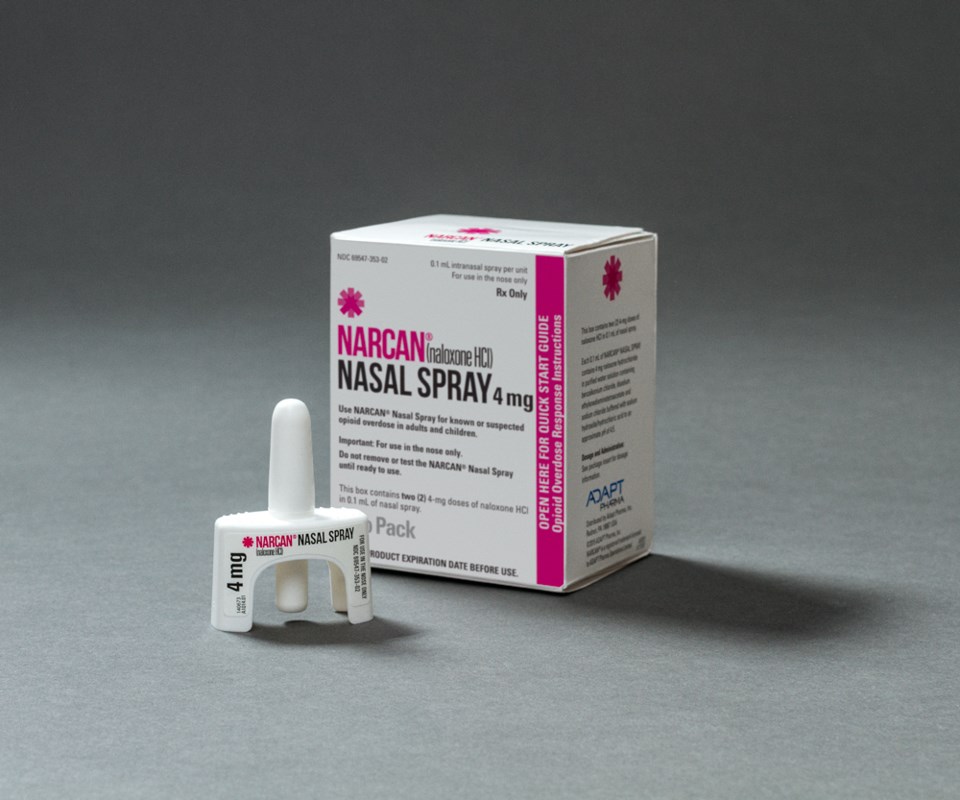A Vancouver police officer working at a Vancouver Canucks hockey game has become the first member of the department to use the overdose-reversing drug naloxone on an overdose victim.
Staff Sgt. Bill Spearn of the VPD’s organized crime section said the officer was working with a partner Dec. 28 at a Canucks game at Rogers Arena and noticed a commotion outside one of the gates involving a man who collapsed on the ground.
“So [two officers] brought him inside Rogers Arena, he didn’t have a ticket and he appeared to be homeless,” Spearn told the Courier Thursday outside a Vancouver Police Board meeting, where he had delivered a presentation on the opioid overdose crisis. “Our members had been trained in the use of our nasal naloxone that we distribute to them, and they immediately observed the signs of what they believed was an opioid overdose.”
Spearn said one of the officers used his naloxone spray on the victim, who was in and out of consciousness and had problems breathing. About 30 seconds later, the man was alert and talking to two officers. He admitted using heroin, which is the illegal drug mostly likely to be laced with the deadly synthetic narcotic, fentanyl.
“I can’t remember the last time I saw heroin that wasn’t adulterated with fentanyl – it’s been a long time,” said Spearn, a 20-year member of the department, who noted paramedics concluded the man had suffered an overdose. “The ambulance crew agreed that, yeah, absolutely, what they had done was the right thing, and that they saved his life by doing it.”
More than 800 Vancouver police officers and staff are trained to use naloxone. As of November, officers are no longer subject to an investigation by the Independent Investigations Office for administering naloxone or performing CPR on a victim that suffers serious harm, or dies. The policy did not apply to paramedics and firefighters, who also administer naloxone.
Asked if the scrapping of the policy has changed officers mindset about using naloxone, Spearn said "our members would not walk by somebody in need of help on the street. Really [the policy] would be secondary in their minds. Does the change in policy help? Absolutely. But I still don't think our members would hesitate for a moment to jump in and do something."
Spearn’s presentation to the police board revealed that 922 people died of an overdose in B.C. in 2016, not the widely reported 914. He said toxicology tests take time and the B.C. Coroners Service continues to update the statistics for last year.
“You almost have to check the coroners website every day,” he said. “It’s discouraging.”
The coroners service reported last week that 116 people died in B.C. in January, with 45 of those in Vancouver. For February, Spearn said, the number of deaths appears to be decreasing, with 15 in Vancouver as of Thursday.
He traced the beginning of the crisis back to Thanksgiving Day in 2014, when staff at the Insite supervised drug injection site reported an unusual spike in overdoses. Police rushed a sample of the drug being used in the area to a Health Canada lab and determined the presence of fentanyl.
Since that incident, the VPD has focused its drug squads’ work on getting fentanyl off the street, completing six projects, including a recent operation Feb. 3. In one of those investigations, a 53-year-old man was sentenced to 13 years and 144 days for drug offences, largely connected to the possession and selling of fentanyl.
In that case, a medical doctor testified that much of the blame for the opioid crisis can be traced to medical doctors over-prescribing opioids as pain medication. Dr. Mark Kennedy said doctors were convinced by prescription drug companies in the 1990s that opioid painkillers were effective and rarely caused addiction.
As doctors began to understand the risks, they started to cut patients off their prescriptions. This led to people turning to the street to find their drugs, which increased the demand for heroin and oxycodone.
As Spearn explained in his presentation, it was in 2012 that drug manufacturers developed a newer, safer form of oxycodone, which couldn’t be crushed and injected. So dealers began using fentanyl in place of oxycodone and sold it as oxycontin. Drug users didn’t know they were buying fentanyl.
Although enforcement is part of combatting the overdose crisis, Spearn told board members that police continue to lobby for treatment-on-demand for drug users. More work also has to be done on prevention and education, he said.
“This is a complex issue and the VPD can’t solve it by arresting its way out of it,” he said.
Vancouver firefighters have administered naloxone 177 times since the department began using the injectable form of the drug last spring, according to Jonathan Gormick, public information officer for Vancouver Fire and Rescue Services.
@Howellings



